Introduction
The DJI Phantom 3 Professional (Model: Phantom 3 Professional, FCC ID: SS3-WM3231503) stands as a benchmark in consumer drone technology, designed specifically for aerial photography and videography enthusiasts seeking uncompromising quality and reliability. Featuring advanced flight control systems and impressive camera capabilities, the Phantom 3 Professional sets itself apart in the competitive drone market. Its FCC certification under ID SS3-WM3231503 confirms compliance with US electromagnetic interference standards, ensuring it is legal for sale and safe operation in the United States.
In this comprehensive analysis, we delve into the Phantom 3 Professional’s key specifications, wireless technologies, internal components through a detailed teardown, and regulatory insights from its FCC filing. Understanding these elements provides clarity on how DJI achieves superior flight performance, precise image capturing, and compliance with stringent FCC requirements. Whether you’re a tech enthusiast, engineer, or aspiring drone operator, this detailed exploration offers valuable insights into DJI’s design and engineering prowess.
Key Features & Specifications
Key Features:
- Return to Home (RTH) Functionality: Includes Smart RTH, Low Battery RTH, and Failsafe RTH, ensuring safe drone recovery under various scenarios.
- Intelligent Orientation Control (IOC): Simplifies drone operation by maintaining consistent flight orientation.
- Vision Positioning System: Enables precise hovering even without GPS, ideal for indoor or GPS-denied environments.
- Integrated Gimbal: Provides unmatched camera stability, resulting in smooth, professional-grade footage.
- Flight Recorder: Stores critical flight data, useful for diagnostics and flight analysis.
- DJI Intelligent Flight Battery (4480 mAh): Offers extended flight times and enhanced battery management for safer operation.
- Camera Capabilities: Captures stunning 4K video and crystal-clear 12-megapixel still images.
Technical Specifications:
- GPS and Vision Positioning Sensors: Accurate positioning and stability.
- Camera Resolution: 12 megapixels still images; 4K video recording capability.
- Failsafe RTH: Automatically activated if the remote controller signal is lost for more than 3 seconds.
- Low Battery RTH: Triggered based on battery level and drone distance from Home Point.
- Flight Modes: Positioning (P), Attitude (A), Function (F).
- Bluetooth Connectivity: Present but specific details not disclosed.
- Battery Capacity: 4480 mAh, intelligent battery management for optimized flight safety.
Operating Frequencies
The Phantom 3 Professional operates within specified frequency ranges, as detailed in its FCC filing:
| Frequency Range (GHz) | Output Power (mW) | FCC Rule Part |
|---|---|---|
| 2.4065-2.4765 | 746 | 15CMO1 |
These frequencies support robust wireless control and video transmission, ensuring reliable drone operation and high-quality live video feeds.
Technology Deep Dive
The Phantom 3 Professional incorporates advanced wireless technologies, primarily operating in the widely-used 2.4 GHz ISM band. This frequency range is commonly utilized for Wi-Fi and Bluetooth communications, offering a balanced compromise between range, bandwidth, and power consumption. Operating at 746 mW output power ensures strong signal integrity, enabling reliable control and clear video streaming over substantial distances.
The use of 2.4 GHz technology, combined with DJI’s Lightbridge system, provides exceptional HD video downlink capabilities, minimizing latency and interference. However, the crowded nature of the 2.4 GHz spectrum means careful design considerations, such as EMI shielding and robust PCB layouts, are essential to maintaining reliable connectivity and performance.
In-Depth Internal Component Analysis / Teardown
The main processor board features a large, centrally placed BGA package, likely an advanced SoC responsible for flight control and data processing. Surrounding ICs appear to manage motor control and power distribution. The PCB employs a multi-layer design, evident from the dense routing and numerous vias, ensuring signal integrity and efficient power management. Connectors strategically placed facilitate modular assembly and maintenance. Overall, the sophisticated layout underscores DJI’s commitment to reliability and flight stability.
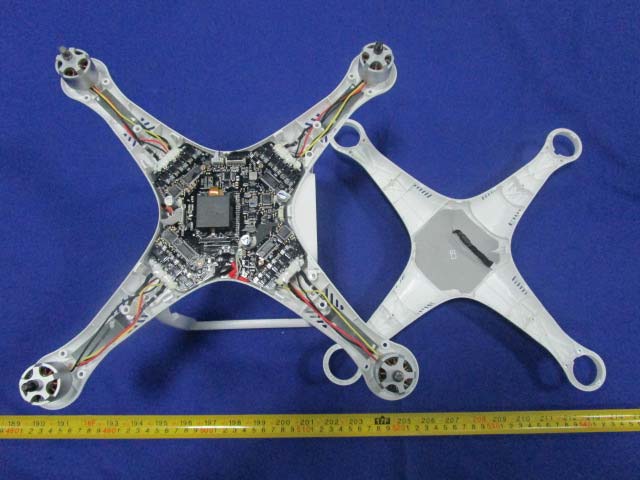
A circular PCB module houses a shielded RF component, likely facilitating GPS or wireless communication. The metal shielding suggests sensitivity to electromagnetic interference, critical for maintaining robust RF performance. Wires soldered directly onto the board indicate interfaces for power and data signals, highlighting a compact design optimized for integration within the drone’s structure.
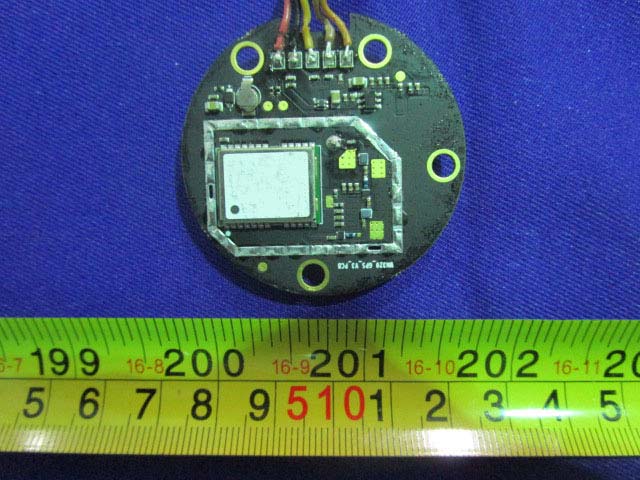
This compact PCB section prominently features a metal-shielded IC, strongly indicating a GPS or RF communication module. The dense arrangement of passive components and power filtering capacitors ensures stable operation. The presence of shielding emphasizes DJI’s meticulous approach to interference mitigation, critical for reliable drone performance.
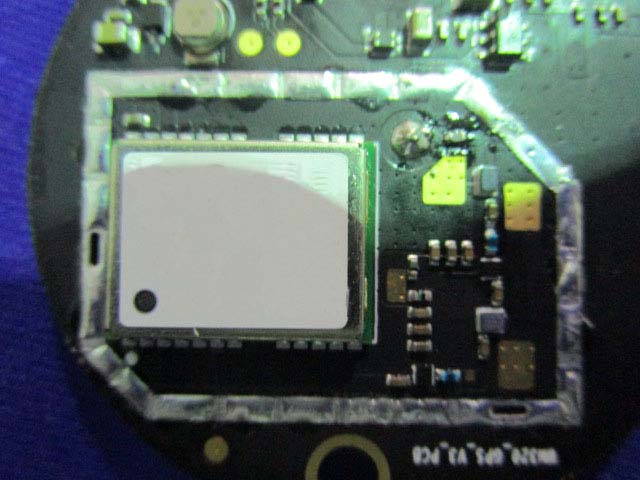
A dedicated GPS module with a ceramic patch antenna highlights DJI’s focus on precise location tracking. The simple, circular PCB layout with minimal components suggests efficient integration into the drone’s overall navigation system. The ceramic antenna ensures optimal GPS signal reception, essential for accurate hovering and navigation.
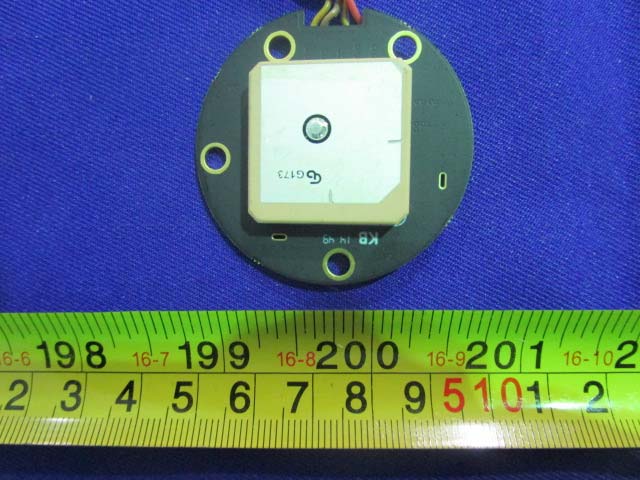
The PCB hosts a robust SoC and accompanying memory ICs, critical for drone control and video processing. High-density component placement and carefully routed differential pairs ensure high-speed data integrity. Visible connectors indicate modularity, facilitating easier assembly and potential repairs.

A sensor module, likely an image sensor, is central to this PCB. Its compact black PCB design prioritizes the sensor’s performance, with minimal additional components visible. The streamlined layout emphasizes DJI’s commitment to high-quality imaging capabilities.
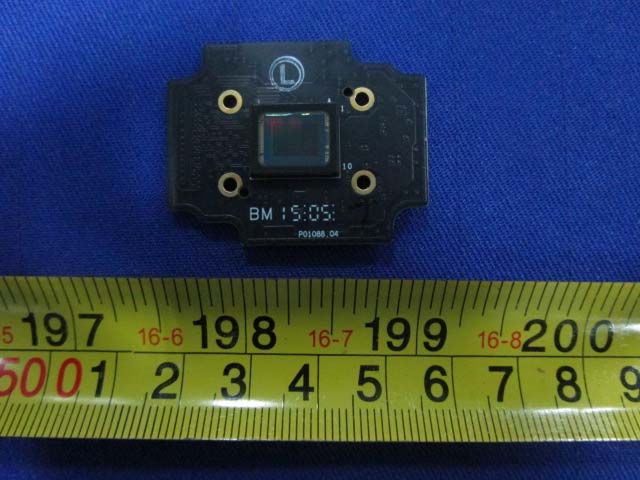
Regulatory Insights & FCC Filing
The FCC ID SS3-WM3231503 certifies that the Phantom 3 Professional meets stringent US electromagnetic interference standards, legally permitting its sale and use. FCC filings typically include RF exposure test results, EMC reports, internal and external photographs, manuals, schematics, and block diagrams. User manual analysis highlights DJI’s emphasis on safety and precision, including features such as Vision Positioning, Intelligent Flight Battery management, and multiple flight safety modes.
Potential Use Cases & Target Audience
The Phantom 3 Professional excels in scenarios demanding high-quality aerial imagery and precise flight control:
- Professional Photography & Videography: Ideal for content creators and filmmakers needing stable, high-resolution aerial footage.
- Surveying & Mapping: Beneficial for professionals requiring accurate spatial data and imagery in construction, agriculture, or environmental monitoring.
- Emergency Response & Inspection: Useful for rapid deployment in search-and-rescue operations or infrastructure inspections, where GPS-denied environments may be encountered.
Conclusion
The DJI Phantom 3 Professional (FCC ID: SS3-WM3231503) represents a culmination of advanced drone technology, superior camera integration, and robust regulatory compliance. Its sophisticated internal components, precise engineering, and thoughtful design choices underscore DJI’s leadership in the drone industry. With its comprehensive FCC certification, the Phantom 3 Professional confidently maintains its position as a trusted, high-performance aerial imaging platform.